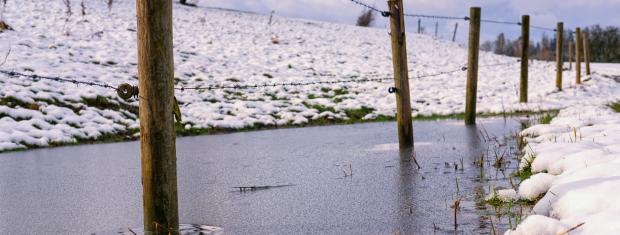
Maintaining a Dry Basement this Spring
The long months of cold temperatures and snow are slowly but surely coming to an end! As we begin to watch the spring thaw, we prepare for the next element of mother nature that is fast approaching – rain.
With vast accumulations of snow melting and rainy days to come, your basement is more vulnerable to flooding. Whether the water damage in your basement was caused by flooding, drainage issues, burst pipes, or clogged gutters – the cost to pump out standing water and repair the damage easily adds up to thousands of dollars.
A flooded basement can be more than an inconvenience, it can also become a health hazard. Following water removal, and after the area has dried, there is still plenty of opportunity for mold.
Preventative maintenance and cleaning up quickly after damage are critical to keeping costs down. Here are a few things to consider helping to safeguard your basement from potential water damage:
Sealants
Cracks in the concrete of a foundation is the most common entry point for water to leak into a basement. Special sealants can be injected into these cracks to seal off and prevent any potential moisture and leaks from seeping through. Many of the sealants come with multi-year warranties.
If you don’t have a foundation crack, you can use concrete waterproof coatings in your basement to permanently seal against potential floods, major leaks, dampness, and condensation problems.
Gutters and Downspouts

Your gutters and downspouts are one of your homes first lines of defense against in channeling roof water away from your home. If your gutter system is not placed strategically, water can easily build at the base of your foundation resulting in a buildup of pressure that could cause water to leak through into your basement. Before any basement leaking disasters hit this upcoming season, here are a few precautionary steps to take:
Cleaning Gutters
Once snow starts to melt, you might notice your gutters are not draining properly due to some sort of buildup – like twigs and leaves. Without clearing the blockage, water can easily overflow into areas that aren’t intended to have water. Always check and clean your gutters before the rainy season begins.
Downspout Placement
Although having downspout sticking out in the middle of your lawn can be an eye sore, it is a crucial step in keeping your basement dry. Your downspouts help to organize the flow of rainwater from your gutters away from your foundation.
Attaching a downspout extension of 6-8 feet will ensure all rainwater is directed far enough away from your home. Keep in mind the further the water drains away from your foundation, the less likely it will seep into your basement.
Grading
The soil around the foundation of your home should slope away from the house to reduce the amount of rainwater that comes into contact with it, preventing leaking. Majority of newly constructed homes are set on property with the yard sloping away from the home. However, overtime, yards can lose this slope through landscaping, home improvements, settlement, etc.
Adding Soil
Sometimes you can get away with simply adding a few inches of soil next to your foundation, changing the direction of the slope and redirecting the water. Generally, you should keep the top of your landscaping soil a minimum of 6 inches below the top of your foundation to prevent damage to your siding.
Building a Trench
For homes built close in proximity to one another, a small trench can be dug to encourage the water to drain. The trench can be left unfilled, or a French drain can be installed.
Install a Drainage System
If water accumulates on your property after every rainfall, you might consider investing in a more extensive drainage system. Bury large corrugated plastic drain tubing a few inches underground, and direct the water to a better drainage location, such as the street. If you’d rather leave the project up to the professionals, contact your local plumber to help design a custom installation to safeguard your home.
Window Wells

Window well drainage can be a very common basement waterproofing problem. Poor installation, wrong window well sizing, and lack of sufficient drainage can all lead to water seeping through windows into your basement.
Installation and Sizing
If you believe the root of the problem comes from improper installation or sizing, or you’re just unsure, contact a local basement waterproofing contractor to assess what must be done to correct the structure.
Drainage
When water enters a galvanized window well it should not be allowed to accumulate and must be drained out. If a lot of water enters the window well, stronger drainage provisions, apart from the gravel layer must be provided to drain the water. Installing a window well drain or cover will help drain out large amounts of water and prevent it from seeping into the tiles.
Sump Pumps
A sump pump collects the water in your basement and pups that water outside, away from your home. If you don’t already have one, installing one will likely solve your flooding problem.
If you already have a sump pump, make sure you’re maintaining it on a regular basis and preventing blockages. You can check if your sump pump is working correctly by pouring water into the sump pit. If the pump automatically starts, it is functioning correctly.
You can save time and money by taking a few of the above preventative measures before spring showers arrive. Although you will likely need a separate flood insurance policy for different types of flooding, there are some options available for water damage under your homeowners policy.


